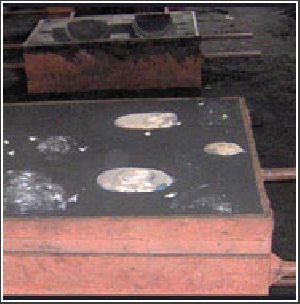
permanent mould castings
Some of the products made using Gravity Die casting process are Housings, Junction boxes, impellers, Valve bodies, Flanges, Manifolds,Actuator bodies, Compressor parts, Electrical fittings parts, Covers. Permanent mould casting get their name from the fact that the process utilizes permanent metal moulds instead of temporary sand moulds for the casting process. Cast iron is the most commonly used mould materials as it offers great reliability during casting. The cores are made from other metals or sand. The cavity surfaces of the moulds are coated with fine layers of materials that have good heat-resistant properties such as clay or sodium silicate. The moulds used in casting are pre-heated upto 200 ºC (392 ºF) before the molten metal is poured into the cast cavity. Casting has to be done with care in order to ensure that proper thermal balance in maintained throughout the casting process. This is done through a variety of ways including external cooling techniques using water or relevant radiation techniques.Gravity die casting, while not offering the same level of design flexibility and ease pattern usage as sand castings, it has the advantage of offering relatively lower design and development costs as well as production costs. At VJP, we have the expertise to undertake permanent mould castings or gravity die casting of complex components of diverse application in various industries.
...more
NO BAKE MOULDING
No Bake is a casting process that uses chemical binders to bond the molding sand. The sand is then transported to the mold fill station in preparation for filling of the mold. A mixer is then used to blend sand with the chemical binder and the catalyst. When the sand exits the mixer, the binder begins the hardening process. After the compaction process, a rollover process is used to remove the mold from the pattern box. The mould is then readied for handling the molten metal. After a shakeout process, the molded sand is taken away from the casting. Then various procedures follow including the finishing and the sand can be reclaimed by thermal means. The chemical nature of the binders makes this a highly specialized process that has to been handled with considerable expertise and knowledge. At VJP, we have developed our expertise in the process over the years and today are able to harness the potential of the process to create casts of the highest quality and to a great degree of accuracy. Features Chemical binders are used to create high strength moulds. When the temperature is brought to normal levels, the molds turn rigid. Advantages It is adaptable to any quantity It creates high strength moulds & improves dimensional repeatability Requires low skill and labor requirements Provides better dimensional control. Applications Ideal for high value and critical parts Desired for Complicated Profiles
...more
Green Sand Moulding
This process derives its name from the presence of moisture in molding sand and is indicator of the unbaked nature of the mould. Raw sand is obtained and processed to provide a consistent distribution of grain sizing. A variety of additives such as pitch, cellulose, and silica flour are used in the process. This process of molding offers a great deal of flexibility in pattern design and consequently in the mould design at very economical costs. At VJP, we have adapted the green sand process to mechanical and automated production methods to ensure speed and efficiency. Features Low material costs Reclaimable mould material. Environmentally friendly. Ensures strong and rigid moulds. Advantages These molds are relatively inexpensive to produce, since the basic material is readily available. Complex patterns can be accommodated in the in the mold design, at affordable costs. Easily adapts to automated production methods.
max weight : 250 Kgs
...more
ANODIZED ALUMINIUM CASTINGS
"VJP has setup a new anodizing plant to accomplish customer or ders on time. This page provides the details of the anodizing plant at VJP and also the process details for technical understanding." Anodizing is an electrolytic passivation process used to increase the thickness of the natural oxide layer on the surface of metal parts. Anodizing increases corrosion resistance and wear resistance, and provides better adhesion for paint primers and glues than bare metal. Anodic films can also be used for a number of cosmetic effects, either with thick porous coatings that can absorb dyes or with thin transparent coatings that add interference effects to reflected light. Anodizing is also used to prevent galling of threaded components and to make dielectric films for electrolytic capacitors. Anodizing most closely resembles standard electroplating. When a reactive metal is suspended in an electrolytic bath as an anode and current is passed through the bath oxygen is produced at the anode surface. This oxygen reacts with the metal to form a thin oxide film that generates colors. The transparent oxide increases in thickness in relation to the amount of voltage applied. At any given voltage the oxide will grow to a specific thickness (i.e. color) and stop, having reached a stage where current will no longer pass. Sulphuric AnodizingSulfuric anodize, commonly referred to as Type II anodizing, is formed by using an electrolytic solution of sulfuric acid at room temperature and a current density of 15 to 22 Amps per square foot. The process will run for 30 to 60 minutes depending on the alloy used. This will produce a generally clear coating, depending on sealing, a minimum of 8ìm thick. One third of the coatingsquare foot. The process will run for 30 to 60 minutes depending on the alloy used. This will produce a generally clear coating, depending on sealing, a minimum of 8ìm thick. One third of the coating Value Additions Can handle large size parts Sizes of 4.5mx2 m. Coloring. Integrated paint shop.
...more
Aluminium High Pressure Aerospace Castings
Color : As per availability
Country of Origin : Made in India

Aluminium Die Casting

Aluminium Cast Alloy

Sand Die Casting Aluminium
Be first to Rate
Rate This